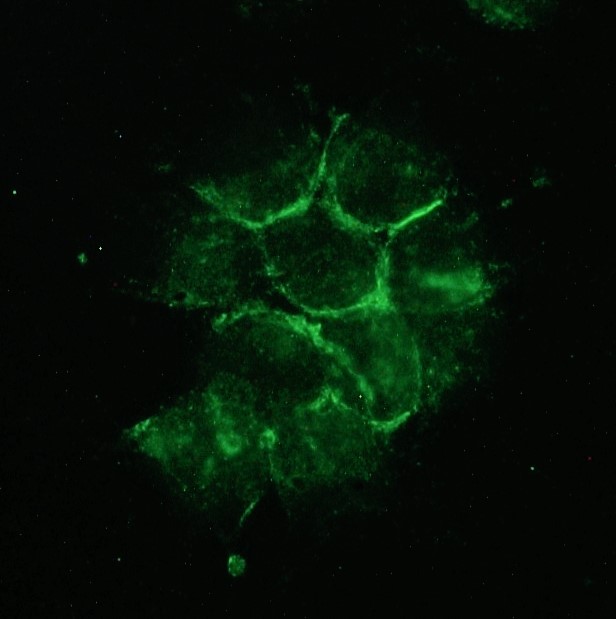Catalogue

NCAM / CD56, neural cell adhesion molecule-1 (123A8)
Catalog number: MUB2033P| Clone | 123A8 |
| Isotype | IgG1 |
| Product Type |
Primary Antibodies |
| Units | 0.1mg |
| Host | Mouse |
| Species Reactivity |
Human |
| Application |
ELISA Flow Cytometry Immunocytochemistry Immunohistochemistry (frozen) Immunohistochemistry (paraffin) Western Blotting |
Background
NCAM / CD56, as a member of the immunoglobulin superfamily of adhesion molecules is characterized by several immunoglobulin (Ig)-like domains. The extracellular part of NCAM consists of five of these Ig domains and two fibronectin type III homology regions. NCAM is encoded by a single copy gene composed of 26 exons. However, at least 20-30 distinct isoforms can be generated by alternative splicing and by post-translational modifications, such as sialylation.
During sialylation, polysialic acid (PSA) carbohydrates are attached to the extracellular part of NCAM. Through its extracellular region, NCAM mediates homophilic interactions. In addition, NCAM can also undergo heterophilic interactions by binding extracellular matrix components, such as laminin, or other cell adhesion molecules, such as integrins.
NCAM can be found in central and peripheral nerve cells, neuroendocrine tissues and at the surface of NK-cells. Also, NCAM is present in malignancies derived from these tissues and cells.
Source
123A8 is a mouse monoclonal IgG1 antibody derived by fusion of mouse myeloma cells with cells from a mouse immunized with a membrane preparation of a human small cell lung carcinoma
Product
Each vial contains 100µg 1mg/ml purified monoclonal antibody in phosphate buffered saline (PBS) containing 0.09% sodium azide.
Formulation: Each vial contains 100µg 1mg/ml purified monoclonal antibody in phosphate buffered saline (PBS) containing 0.09% sodium azide.
Specificity
The antibody 123A8 is directed against human NCAM/CD56 and reacts with an epitope within the membrane-proximal region of the NCAM molecule. The antibody binds to all NCAM isoforms.
Applications
The 123A8 antibody is suitable for the detection of human NCAM/CD56 by flow cytometry, immunocytochemistry, ELISA, western blotting and immunoprecipitation.
The antibody is also suitable for the detection of human NCAM/CD56 by immunohistochemistry on frozen and paraffin embedded tissues. Staining of paraffin embedded tissues with 123A8 is possible following heat mediated antigen retrieval of paraffin sections using 10mM citrate buffer, pH 6.0.
Optimal antibody dilutions for the different applications should be determined by titration.
Storage
The antibody is shipped at ambient temperature and may be stored at +4°C. For prolonged storage prepare appropriate aliquots and store at or below -20°C. Prior to use, an aliquot is thawed slowly in the dark at ambient temperature, spun down again and used to prepare working dilutions by adding sterile phosphate buffered saline (PBS, pH 7.2). Repeated thawing and freezing should be avoided. Working dilutions should be stored at +4°C, not refrozen, and preferably used the same day. If a slight precipitation occurs upon storage, this should be removed by centrifugation. It will not affect the performance or the concentration of the product.
Caution
This product is intended FOR RESEARCH USE ONLY, and FOR TESTS IN VITRO, not for use in diagnostic or therapeutic procedures involving humans or animals. It may contain hazardous ingredients. Please refer to the Safety Data Sheets (SDS) for additional information and proper handling procedures. Dispose product remainders according to local regulations.This datasheet is as accurate as reasonably achievable, but Nordic-MUbio accepts no liability for any inaccuracies or omissions in this information.
References
1. Moolenaar CE, Muller EJ, Schol DJ, Figdor CG, Bock E, Bitter-Suermann D, Michalides RJ.(1990). Expression of neural cell adhesion molecule-related sialoglycoprotein in small cell lung cancer and neuroblastoma cell lines H69 and CHP-212. Cancer Res. 50:1102-1106.
2. Langdon SP, Hawkes MM, Hay FG, Lawrie SS, Schol DJ, Hilgers J, Leonard RC, Smyth JF. (1988). Effect of sodium butyrate and other differentiation inducers on poorly differentiated human ovarian adenocarcinoma cell lines. Cancer Res. 48:6161- 6165.
3. Langdon SP, Lawrie SS, Hay FG, Hawkes MM, McDonald A, Hayward IP, Schol DJ, Hilgers J, Leonard RC, Smyth JF. (1988). Characterization and properties of nine human ovarian adenocarcinoma cell lines. Cancer Res. 48:6166-6172.
4. Gerardy-Schahn R, Eckhardt M. (1994). Hot spots of antigenicity in the neural cell adhesion molecule NCAM. Int J Cancer Suppl.8:38-42.
5. Kwa HB, Wesseling J, Verhoeven AH, van Zandwijk N, Hilkens J. (1996). Immunoscintigraphy of small-cell lung cancer xenografts with anti neural cell adhesion molecule monoclonal antibody, 123C3: improvement of tumour uptake by internalisation. Br J Cancer. 73:439-446.
6. Advances in the applications of monoclonal antibodies in clinical oncology. (1987). Abstracts. Br J Cancer. 56:509-530.
Safety Datasheet(s) for this product:
| NM_Sodium Azide |

|
Figure 1. Indirect immunofluorescence staining of NCAM/CD56 at the attachement sites of the human small cell lung cancer cell line NCI-H82 using MUB2033P, clone 123A8 at a dilution of 1:200. |

Figure 1. Indirect immunofluorescence staining of NCAM/CD56 at the attachement sites of the human small cell lung cancer cell line NCI-H82 using MUB2033P, clone 123A8 at a dilution of 1:200.
